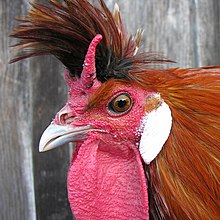Appenzeller Spitzhauben
Alemannic German: Gässerschnäpfli | |
| Country of origin | Switzerland |
|---|---|
| Distribution |
|
| Use | eggs |
| Classification | |
| APA | no[4] |
| EE | yes[5] |
| PCGB | soft feather light[6] |


The Appenzeller Spitzhauben is a Swiss
History
The origins of the Spitzhauben are unknown.[8]: 8 It has been bred in the mountains of the Alpine region for hundreds of years.[7] A similar breed, the Brabanter of the Low Countries, is shown in paintings of the seventeenth century; it has been suggested that the Spitzhauben may have originated at about that time.[9]: 36
In the twentieth century it was found only in the historical
Characteristics
The Spitzhauben is a light chicken: hens weigh little more than a kilogram, and cock birds barely over 1.5 kg.[12] It is an active breed that doesn't do well in close confinement, can forage well, and will roost in trees if given the opportunity. In North America, it is very rare and is recognized officially by neither the American Poultry Association or other breed registries. The silver-spangled Spitzhauben is the most common variety.
The Spitzhauben variety, meaning "pointed bonnet", has a V-comb and feather crests in males and females. The word 'spitzhauben' derives from a ceremonial hat worn by the women in the Appenzeller region in Switzerland. The breed was imported into America by a doctor. Spitzhauben are recognised by the EE Standard commission in the following colours: silver-spangled, gold-spangled, lemon-spangled, chamois-spangled, pure black and pure blue.
Ring size is 16 mm for cocks and 15 mm for hens.[13][14]: 4
Use
Hens may lay some 150 white-shelled eggs in their first year, with an average weight of 55 g.[12][15]
References
- ISBN 3258066698. Archived 24 May 2022.
- ISBN 9789251057629. Archived 23 June 2020.
- ^ Breed data sheet: Appenzeller Spitzhauben / Switzerland (Chicken). Domestic Animal Diversity Information System of the Food and Agriculture Organization of the United Nations. Accessed January 2022.
- ^ APA Recognized Breeds and Varieties: As of January 1, 2012. American Poultry Association. Archived 4 November 2017.
- ^ Liste des races et variétés homologuée dans les pays EE (28.04.2013). Entente Européenne d’Aviculture et de Cuniculture. Archived 16 June 2013.
- ^ Chickens: Soft Feather Light. Poultry Club of Great Britain. Archived 9 November 2018.
- ^ a b c Appenzeller Spitzhauben (in German). Gesellschaft zur Erhaltung alter und gefährdeter Haustierrassen. Accessed January 2022.
- ^ Norbert Niemeyer (2011). Hühner aus dem Appenzeller Land (in German). Geflügelzeitung 23/2011. Berlin: HK Verlagsgesellschaft.
- ISBN 9781119509141.
- ^ a b Tiergenetische Ressourcen der Schweizer Landwirtschaft (in German). Bern: Bundesamt für Landwirtschaft. Accessed February 2022.
- ^ a b Appenzeller Spitzhaubenhuhn (in German). ProSpecieRara Schweiz. Accessed January 2022.
- ^ a b Das Appenzeller Spitzhaubenhuhn (in German). Neukirch an der Thur: Züchterverein für ursprüngliches Nutzgeflügel. Archived 5 November 2016.
- ^ Rassename: Appenzeller Spitzhauben. Entente Européenne d’Aviculture et de Cuniculture. Accessed February 2022.
- ^ [s.n.] (2021). Ringgrössenverzeichnis/Liste des bagues (in German and French). Standard- und Fachkommission von Rassegeflügel Schweiz/Commission du standard et technique de Volailles de race Suisse. Accessed March 2022.
- ^ Rassetafeln: Hühner (in German). Reichenbach, Haselbachtal: Bund Deutscher Rassegeflügelzüchter. Accessed February 2022.
Further reading
- Carol Ekarius (2007). Storey's Illustrated Guide to Poultry Breeds. North Adams, Massachusetts: Storey Publishing. ISBN 9781580176675
- Chris Graham (2006). Choosing and Keeping Chickens. London: Octopus Publishing. ISBN 9780793806010
